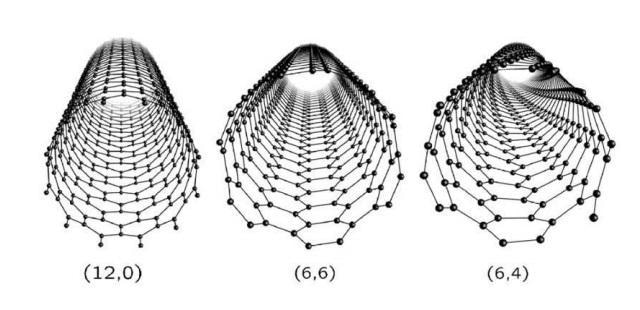Jun 3 2016
Marianna Kharlamova (the Lomonosov Moscow State University Department of Materials Science) examined different types of carbon nanotubes' "stuffing" and classified them according to the influence on the properties of the nanotubes. The researcher's work was published in the high-impact journal Progress in Materials Science (impact factor -- 26.417).
 Schematic representation of the three types of the single-walled carbon nanotubes. The black dots correspond to the carbon atoms, and the lines between them show the relations between the carbon molecules.(CREDIT-Source: Progress in Materials Science)
Schematic representation of the three types of the single-walled carbon nanotubes. The black dots correspond to the carbon atoms, and the lines between them show the relations between the carbon molecules.(CREDIT-Source: Progress in Materials Science)
An 87 pages long overview summarized the achievements of scientists in the field of the investigation of the electronic properties of single-walled carbon nanotubes (SWNTs). 'A detailed systematic study of 430 works was conducted, including 20 author's works, most of which had been published during the last 5 years, as the area under study is actively developing,' says Marianna Kharlamova. Apart from analytical systematization of the existing data, the author considers the theoretical basis of such studies -- the band theory of solids, which describes the interaction of the electrons in a solid.
The Many Faces of carbon: diamonds, balls, tubes
Carbon has several forms of existence (allotropic modifications) and can be found in different structures. It forms coal and carbon black, diamond, graphite, from which slate pencils are made, graphene, fullerenes and others. The whole organic chemistry is based on carbon which forms the molecular backbone. In diamonds the carbon atoms are kept on a strictly specified positions of the crystal lattice (which leads to its hardness). In graphite, the carbon atoms are arranged in hexagonal layers resembling honeycombs. Each layer is rather weakly interacting with the one above and the one below, so the material is easily separated into flakes which look to us like a pencil mark on the paper. If you take one such layer of hexagons and roll it into a tube, you get what is called a carbon nanotube.
A single-walled nanotube is a single rolled layer, and a multi-walled looks like the Russian 'matryoshka' doll, consisting of several concentric tubes. The diameter of each tube is a few nanometers, and the length is up to several centimeters. The ends of the tube are closed by hemispheric "caps" -- halves of fullerene molecules (fullerenes are another form of elemental carbon resembling a soccer ball stitched together from hexagons and pentagons). To make and fill the carbon nanotube is much more challenging than to stuff a wafer curl : to tailor these structures scientists use laser ablation techniques, thermal dispersion in an arc discharge or vapor deposition of hydrocarbons from the gas phase.
SWNT is no cookie
What is so special about them then? The properties of the graphite (electrical conductivity, ductility, metallic shine) remind metals, yet carbon nanotubes have quite different properties, which can be used in electronics (as components of prospective nanoelectronic devices -- gates, memory and data transmission devices etc.) and biomedicine (as containers for targeted drug delivery). The conductivity of carbon nanotubes can be changed depending on the orientation of the carbon hexagons relative to the tube axis, on what is included in its wall besides carbon, on which atoms and molecules are attached to the outer surface of the tube, and what it is filled with. Besides, single-walled carbon nanotubes (or SWNTs) are surprisingly tear-proof and refract light in a particular way.
Marianna Kharlamova was the first to classify types of nanotubes' "stuffing" according to their impact on the electronic properties of SWNTs. The author of the review considers the method of filling SWNTs as the most promising for tailoring their electronic properties.
'This is due to four main reasons,' Marianna Kharlamova says. 'Firstly, the range of substances that can be encapsulated in the SWNT channels is wide. Second, to introduce the substances of different chemical nature into the SWNT channels several methods have been developed: from the liquid phase (solution, melt), the gas phase, using plasma, or by chemical reactions. Third, as a result of the encapsulation process, high degree of the filling of SWNT channels can be achieved, which leads to the significant change in the electronic structure of nanotubes. Finally, the chemical transformation of the encapsulated substances allows controlling the process of tailoring the electronic properties of the SWNTs by selecting an appropriate starting material and conditions of the nanochemical reaction.'
The author herself conducted experimental studies of the filling of nanotubes with 20 simple substances and chemical compounds, revealed the influence of "stuffing" on the electronic properties of nanotubes, found the correlation between the temperature of the formation of inner tubes and the diameter of the outer tubes, and explained which factors influence the degree of the nanotubes' filling.